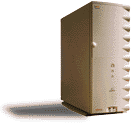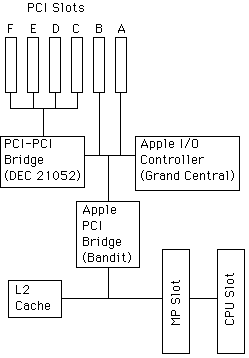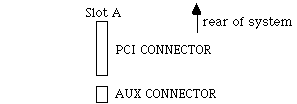

Introduction
This document describes the SuperMac S900 computer from UMAX Computer Corporation. This product is a derivative of the Apple Computer Power Macintosh 9500 product, which is based on the PowerPC RISC microprocessor.
In an effort to reduce cost, increase manufacturability, and provide an enhanced feature set, the SuperMac S900 features a unique PCB design, which is roughly divided into 3 PCBs:
- The main logic board PCB includes all core logic specific to this architecture,
- The PowerPC microprocessor is presented on a user swappable PCA, and
- In order to get sufficient I/O connectors from the rear of the computer, a small connector card is plugged into the main logic board. This board also includes the system's built-in networking capabilities.
An industry standard ATX enclosure is utilized for this system. As a Mini-Tower design, it features significantly enhanced device expandability and a standard power supply. A custom bezel industrial design is used to differentiate the computer visually.
Features
The SuperMac S900 system has the following features:
- 100% Mac OS Compatibility
- 604 PowerPC Processor at 150 MHz (604e processor used above 150Mhz)
- ATX form factor chassis design
- Built-in 16 MBytes of interleaved DRAM
- Multiprocessing-Ready - 2nd CPU Card Slot
- 1 Enhanced PCI Slot for E100 UltraSCSI/100Base-T card
- 6 PCI slots for PCI cards with standard brackets
- PCI card brackets secured to chassis with mounting screws
- DEC 21052 PCI-PCI bridge chip provides direct PCI-PCI card data transfers
- DRAM Expansion up to 1GB via 8 DIMM sockets
- 128 bit data path from DRAM to processor
- 4 MBytes of 64 bit wide burst ROM
- 512KB Level 2 SRAM Cache
- Integrated SWIM III floppy interface (800/1.44 MByte floppy)
- ADB Keyboard and Mouse
- Lithium Battery backed-up Clock/Calendar/Parameter RAM
- Two Macintosh Serial Ports compatible with Local Talk, GeoPort
- 16 bit CD-Quality Stereo sound
- Analog CD audio recording/playthrough
- Audio Out stereo jack on the rear panel
- Stereo Audio In jack Apple PlainTalk Microphone/Line Input.
- Stereo Audio In/Out jacks forward-mounted on front bezel
- 53C94 compatible SCSI interface for internal and external devices
- Fast SCSI-II interface for internal devices
- Automatic active termination for external SCSI bus
- On board Ethernet (10Base-T and AAUI connections)
- DMA channels for SCSI, SCC, Ethernet, Floppy, Sound
- 6.7x Speed (or faster) CD-ROM Drive
- 2 3.5" device bays - internal only
- 2 3.5" device bays - forward accessible
- 2 5.25" device bays - forward accessible
- PC-standard 250W soft/trickle power supply
- Front bezel mounted Reset Switch and Programmer´s NMI switch
- Front bezel mounted Power On LED indication
- Front bezel mounted monaural speaker
- Thermal design allows enhanced airflow thru chassis from front to back
Differences Compared to Power Macintosh 9500
The SuperMac S900 implementation has some technical differences compared to the Apple Power Macintosh 9500 computer. These differences are described below.
One Bandit and One PCI-PCI Bridge Chip
The Power Macintosh 9500 uses two Bandit chips to manage the data flow between the processor, the PCI slots, and the rest of the I/O circuitry in the computer. The SuperMac S900 uses one Bandit chip for the top two PCI slots and remaining I/O circuitry. The DEC 21052 PCI-PCI bridge chip directly controls the bottom 4 PCI slots and provides direct PCI-PCI slot communications between all six slots. Data may travel directly between each of the PCI slots at more consistent and higher data rates because it does not have to be routed through main memory and does not have to share the same PCI controller which also manages the I/O circuitry. The SuperMac S900 design also allows the addition of the second processor slot. The general architecture looks like this:

Multiprocessing Slot
The SuperMac S900 has a secondary processor slot placed next to and parallel with the primary processor slot. This slot affords the addition of a second processor card to outfit the system as a two-head asymmetrical multiprocessing computer. It accomplishes this upgrade without the need to throw away the primary processor card. The secondary card shares the same connector type as the primary slot, but because of clocking limitations, it has a different, UMAX Computer Corporation proprietary pinout.
This slot is placed in a physical location that is in-line with PCI Slot A. Because of this, PCI Slot A is limited to half-length PCI cards (less than 6" in length).
E100 Ultra-Wide SCSI/100Base-T Ethernet Card Slot
The SuperMac S900 may be upgraded with an E100 I/O feature card that provides 100Mbit Ethernet and UltraSCSI capabilities. It is implemented as a multifunction PCI card placed in Slot A. It is, however, a little different than most multifunction PCI cards. Both PCI devices on this card share the same physical PCI bus. Signals that cannot be shared are routed through another small auxiliary connector that is placed in-line just forward of the PCI slot:

Of course, if a E100 Card is not placed in this slot, the slot is available for a normal half-length PCI card.
Forward-Mounted Audio Jacks
For the purpose of convenience, the SuperMac S900 includes audio in and audio out stereo jacks on the front bezel. This allows the user to conveniently access sound-out ports for headset use and sound-in ports for microphone use. There is also an audio out port located at the rear of the system. The algorithm for cutoff of sound-out is as follows: The forward jack has the highest priority, the rear next and the internal speaker the last. For example, if one has headphones plugged into the forward jack, the rear jack and the internal speaker are cutoff from any sound. This information is summarized in the following table:
| External Speaker Connection | Sound Playthrough Status | ||
| Front Audio Jack | Rear Audio Jack | Front Speaker | |
| Front Audio Jack | Audio | No Audio | No Audio |
| Rear Audio Jack | No Audio | Audio | No Audio |
| No Connection | No Audio | No Audio | Audio |
Main Memory Expansion
Not including the 16MBytes Interleaved DRAM soldered to the logic board, main memory is expandable to 1GByte because there are 8 DRAM DIMM slots. This amount of memory can be achieved with the use of 128MByte DIMMs. Using 64MByte DIMMs, one can load the system with 512MBytes of total memory.
Networking/Serial Connector Card
The networking connectors (serial and Ethernet) are placed on a connector card that rises from the motherboard in the rear of the system. It is a simple card that mostly contains the connectors.
Industrial Design
The SuperMac S900 is housed in an ATX standard Mini-Tower enclosure. This enclosure affords the system a high degree of expandability, while taking advantage of industry standard components. The design includes a door that covers the externally accessible drive bays. The On/Off button features an integrated LED that indicates that the system is powered ON. Also, INTERRUPT and RESET buttons are located on the bezel. The bottom front of the bezel contains the two stereo audio jacks, one for sound output and one for sound input.
PC-Standard 250W Soft/Trickle Power Supply
The power supply is considered a "soft" power supply because it can be turned on/off through software running on the computer or through the power on key on the keyboard. The "trickle" feature of the power supply provides a small amount of power to the CUDA chip on the main logic board to maintain the date and time when the computer is turned off but plugged into the wall outlet. By eliminating the drain on the PRAM battery while the computer is turned off but plugged in, the life of this battery will be significantly lengthened.
This 5v trickle voltage is not supplied to any of the PCI slot connectors, therefore users may safely insert/remove PCI cards without having to unplug the power cord (as was required on older Apple Quadra 900/950 computers).
Software Features
Operating System
The SuperMac S900 is designed to be fully compliant with the Mac OS operating system as licensed by Apple Computer to UMAX Computer Corporation. In fact, the ROMs soldered onto the SuperMac S900 main logic board are identical to the ROMs installed on the Apple Power Macintosh 9500 ROM SIMM.
Apple Mac OS compatibility certification for the SuperMac S900 guarantees compatibility with future Mac OS system software upgrades to protect the customer's investment in hardware.
Drivers
Disk drivers are based on the FWB Hard Disk ToolkitTM, and the CD-ROM drive uses the FWB CD-ROM ToolkitTM and drivers. In addition, CD Booter software from FWB is mastered onto the SuperMac S900 CD which allows the CD to boot the system.
Bundled Software
The SuperMac S900 will bundle some product-enhancing software. This software will not deviate from standard Mac OS application or system extension software. An example of such a software product could be an INIT conflict evaluation product, which could greatly reduce technical support calls by helping the user to evaluate potentially conflicting extensions.
Problems with this site? Please inform the webmaster.
© Kennedy Brandt, 2002.
